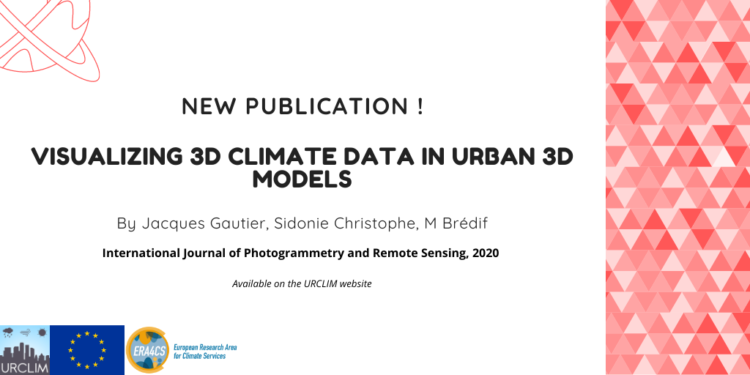Abstract The Clausius‐Clapeyron (CC) relation expresses the exponential increase in the moisture‐holding capacity of air of approximately 7%/°C. Earlier studies show that extreme hourly precipitation increases with daily mean temperature, consistent with the CC relation. Recent studies at specific locations found that for temperatures higher than around 12 °C, hourly precipitation extremes scale at rates…Continue reading Modeling the scaling of short‐duration precipitation extremes with temperature, in Earth and Space Science Journal
Urban climate services: climate impact projections and their uncertainties at city scale, in FMI’s Climate Bulletin
Abstract In many cities across Europe, both urban authorities and private actors have made strong commitments to adapt to future climate changes. Although a lot of climate information is available at the global and regional scale, this is often not the case at the local urban scale. Moreover, such information should account for a wide…Continue reading Urban climate services: climate impact projections and their uncertainties at city scale, in FMI’s Climate Bulletin
Heat related mortality in the two largest Belgian urban areas: A time series analysis, in Environmental Research journal
Abstract Background: Summer temperatures are expected to increase and heat waves will occur more frequently, be longer, and be more intense as a result of global warming. A growing body of evidence indicates that increasing temperature and heatwaves are associated with excess mortality and therefore global heating may become a major public health threat. However,…Continue reading Heat related mortality in the two largest Belgian urban areas: A time series analysis, in Environmental Research journal
A statistical-dynamical methodology to downscale regional climate projections to urban scale, in Journal of Applied Meteorology and Climatology
Abstract The demand of city planners for quantitative information on the impact of climate change on the urban environment is increasing. However, such information is usually extracted from decadelong climate projections generated with global or regional climate models (RCMs). Because of their coarse resolution and unsuitable physical parameterization, however, their model output is not adequate…Continue reading A statistical-dynamical methodology to downscale regional climate projections to urban scale, in Journal of Applied Meteorology and Climatology
Co-Visualization of Air Temperature and Urban Data for Visual Exploration, in IEEEVIS 2020
Abstract Urban climate data remain complex to analyze regarding their spatial distribution. The co-visualization of simulated air temperature into urban models could help experts to analyze horizontal and vertical spatial distributions. We design a co-visualization framework enabling simulated air temperature data exploration, based on the graphic representation of three types of geometric proxies, and their…Continue reading Co-Visualization of Air Temperature and Urban Data for Visual Exploration, in IEEEVIS 2020
Visualizing 3D climate data in urban 3D models, in International Journal of Photogrammetry and Remote Sensing
Abstract In order to understand and explain urban climate, the visual analysis of urban climate data and their relationships with the urban morphology is at stake. This involves partly to co-visualize 3D field climate data, obtained from simulation, with urban 3D models. We propose two ways to visualize and navigate into simulated climate data in…Continue reading Visualizing 3D climate data in urban 3D models, in International Journal of Photogrammetry and Remote Sensing
A new ICOS study has shown a reduction of CO2 emission during the Covid-19 lockdown
This study compares CO2 fluxes from 8 measurement towers in European cities between the lockdown and data from the previous years. Previously, in the URCLIM project, the urban climate model TEB was improved to be able to simulate the CO2 fluxes using the previous years measurements of one of these towers, in Kumpula, Helsinki, Finland.…Continue reading A new ICOS study has shown a reduction of CO2 emission during the Covid-19 lockdown
URCLIM Flash News – April 2020
THE RESEARCH COMMUNITY REMAINS ACTIVE DURING THE LOCKDOWN Due to the exceptional context the world is dealing with, the URCLIM team is still managing activities while teleworking since March 2020. Such activities cannot be put on hold since urban climate information provide core elements for public health policies. As specified by the World Meteorological Organisation,…Continue reading URCLIM Flash News – April 2020
City-descriptive input data for urban climate models: Model requirements, data sources and challenges, in Urban Climate, vol.31
Abstract Cities are particularly vulnerable to meteorological hazards because of the concentration of population, goods, capital stock and infrastructure. Urban climate services require multi-disciplinary and multi-sectorial approaches and new paradigms in urban climate modelling. This paper classifies the required urban input data for both mesoscale state-of-the-art Urban Canopy Models (UCMs) and microscale Obstacle Resolving Models…Continue reading City-descriptive input data for urban climate models: Model requirements, data sources and challenges, in Urban Climate, vol.31
Three steps to pave the way to Urban Climate Services – video
Here is an outreach video shortly describing three important ingredients to pave the way towards European climate services!










